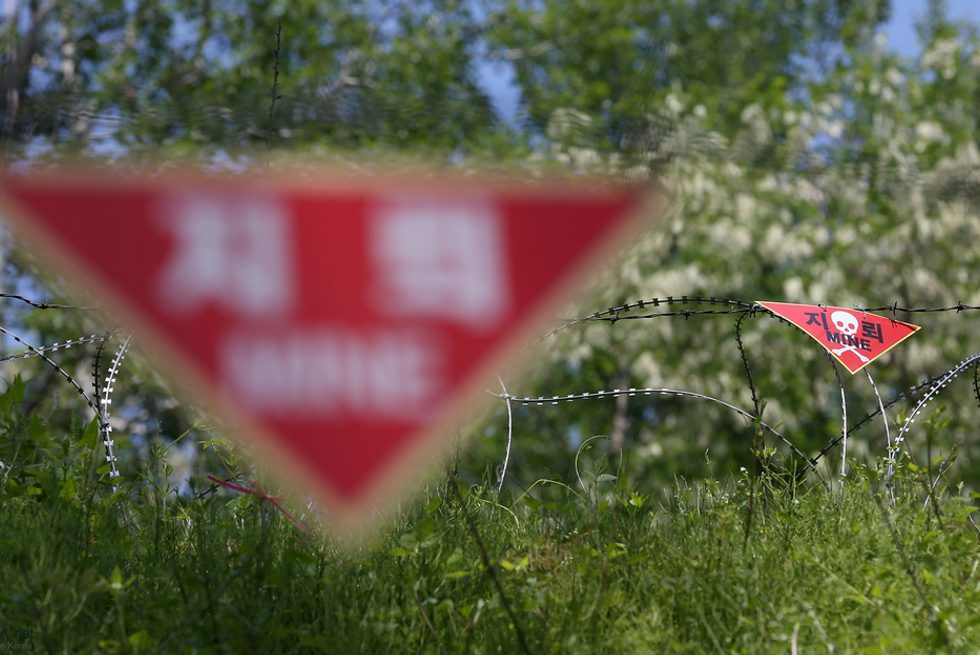This post builds on the research article “Toward an Anthropology of Landmines: Rogue Infrastructure and Military Waste in the Korean DMZ,” which was published in the May 2016 issue of the Society’s peer-reviewed journal, Cultural Anthropology.
Julien Cossette: I would like to start by inviting you to discuss a series of photographs that you took at the recently opened Paju DMZ Village Museum in T’ongil Ch’on (Reunification Village), part of the South Korean Civilian Control Zone (CCZ). On display behind glass vitrines, the rustiness of the mines and other military materials suggest a temporality at odds with the experiences you describe in the article. Could you say more about the exhibition and the ways in which its presentation adds to what you call the “heterogeneous life of landmines”?
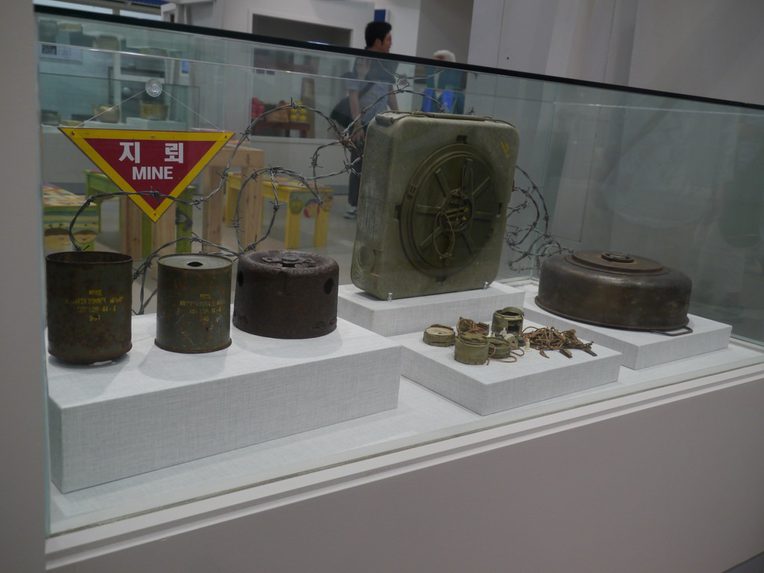
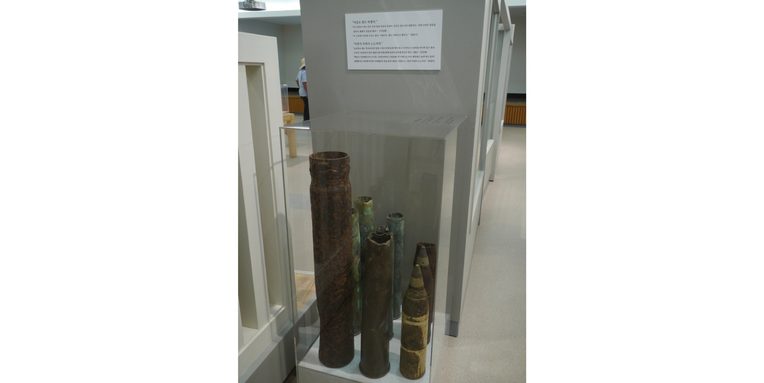

Eleana J. Kim: The ambiguous temporality of the DMZ borderlands in South Korea—postconflict, yet continually on the brink of war—has become heightened over the past several years, as the DMZ-related tourism economy has expanded and diversified. As I discuss in the article, many villages in the border area are being asked to brand themselves and their locally distinctive cultures as part of a so-called Peace and Life Zone for consumption by domestic and international tourists.
Because the war and its detritus constitute such a central part of people’s past and present experiences, the integration of these material realities into postwar narratives of progress and development reveals their inherent ontological, epistemological, and temporal instability. The opening of this museum is itself temporally marked—sixty years after the armistice, the original settlers of Unification Village are elderly and passing away, and the historicization of the village takes shape through the curation of their household artifacts and of oral histories that mark the past as distinct from the present. For instance, the fact that the original residents hailed from all parts of Korea, including as far as Jeju Island, and the syncretization of local customs are highlighted as multiculturalism avant la lettre.
Landmines’ multiple and ambiguous temporalities are at odds with the narrative presented by the museum. Their containment in the glass vitrines frames them as relics of the past, whereas they continue to exist in live form in areas just outside of the museum. Mines’ multiplicity becomes apparent in the quotation in Figure 3, in which past and present are difficult to disentangle from the surrounding (post)war ecology: “The entire area outside the house is an unidentified mine zone.” The original Korean phrase does not indicate tense, but the testimonies that follow describe the tragic losses of villagers in the late 1960s, during a period of heightened national security that followed a North Korean attack on the presidential residence. Yet, as I discuss in the article, mine accidents among soldiers and civilians in the border area are very much present and continue to occur, with three civilian mine accidents already reported since January 2016, including one in neighboring Gangwon province, in which a migrant worker from Kazakhstan lost a leg.
JC: From the museum, let’s move to the visual markers of (unconfirmed) minefields. In the context of tourism, I’m interested by your observation that mine signs come in and out of attention as “ubiquitous fetish objects” that are often reduced to mere “visual static” and left undiscussed. Could you discuss further this process of fetishization and its effects, particularly in regards to what is obscured, such as risk education? Also, would you consider the spectacularization of military infrastructure as a form of what some scholars call dark tourism, or would such an analysis overshadow the ongoing developments in the border zone?
EJK: I’m less interested in typologies of tourism, whether dark, disaster, or security—than in how particular narratives and histories are made available for consumption. In the visual culture of these tours and in representations of the DMZ as a forbidden zone (but also a site where nature and war paradoxically coexist), mine signs and barbed wire are symbolically mobilized to exemplify this ironic state of affairs. These images are part of the diversification of tourist experiences being actively developed by local municipalities and national ministries. For decades, tours to the Joint Security Area have been the most popular for international tourists, but there was only one main package, organized in conjunction with the United Service Organizations (USO). Most South Korean citizens cannot take these tours without special permission.
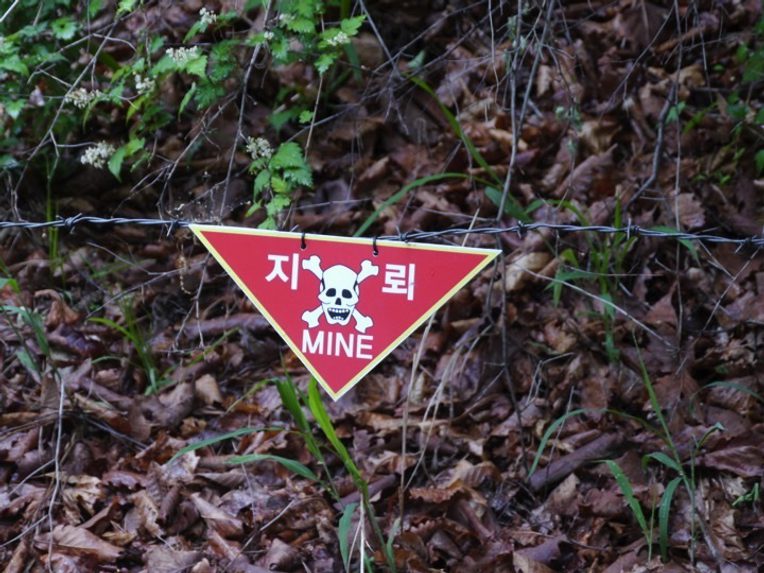
In the past several years, as pressures on local governments to generate capital have increased, DMZ-related tourism has proliferated for domestic tourists. Marathons, cycling tournaments, K-Pop concerts, ecotours, and film festivals are just a few of the ways in which the DMZ brand has been promoted. The most recent development in DMZ tourism is opening of a youth hostel at Camp Greaves, a former U.S. military barracks, where the blockbuster Korean television drama, Descendants of the Sun, was filmed. Another is the Walk Your DMZ promotion, which features the P’yonghwa Nuri-gil or Peace Pleasure Trail, with several paths that bring tourists to premodern and Japanese colonial-era historical sites, military observatories, and ecological areas. The Peace Pleasure Trail is the latest version of what has become a national trend in t’eurekking, or hiking, trails.
When it comes to the promotion of the Peace and Life Zone as a tourist site, however, trekking requires strict boundary maintenance, and new mine signs have proliferated even as risk education continues to be absent. Aside from the replacement of dilapidated signs with more visible new ones, there are also idiosyncratic ones, such as the one regarding North Korean box mines. The banner in Figure 6 was placed at the tourist site of Goseokjeong, along the Imjin River, and it warns observers not to touch the mines. Despite the attempts to make the Peace and Life Zone alluring for international tourists, however, the warning sign here appears only in Korean, and the message would likely be indecipherable for people unfamiliar with the Korean language. The sign in Figure 7 presents a new kind of sign that may become a standard at newly developed tourist locations. This image was taken at an ancient historical site in the Civilian Control Zone, and indicated that the area had been cleared of mines. Yet, the triangular shape, in recalling the red mine warning signs, provokes semiotic ambiguity and physical insecurity. As one blogger wrote in a caption to a photo of the sign, “Seeing these signs everywhere, I realize the sad history in this place. Not knowing where landmines might be, one must stick to the path” (my translation).
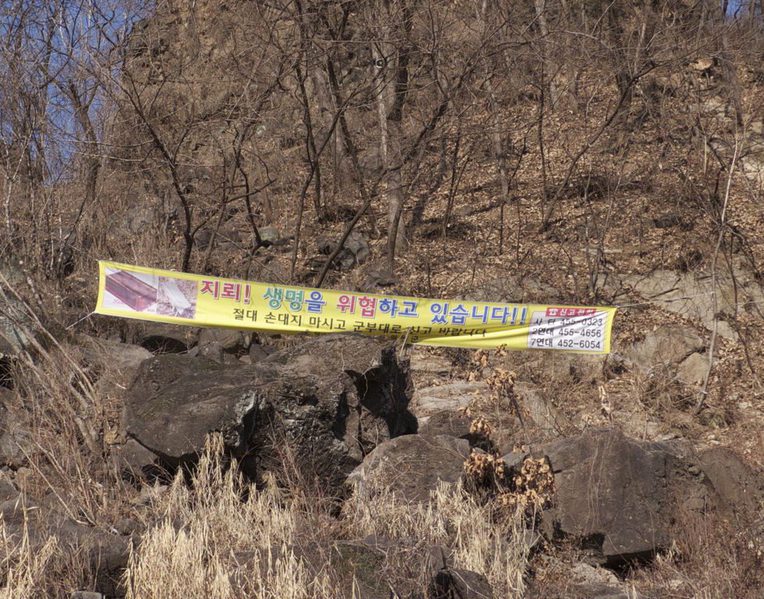

JC: In your article, you address the troubled history of propaganda villages and settlers in the CCZ. For Mr. Lee, civilian mine victims are war heroes who deserve support and “merits of honor bestowed by the state, for their sacrifices at the front lines of an unending war.” Last year, a controversial statue—the Foot of Peace—did materialize in the Pyeonghwa Nuri peace park in the DMZ. The statue celebrates not civilians, but a military search party and two sergeants who were maimed by landmines presumed to have been planted by North Korea. Can you talk a bit about the sculpture, what it represents, and the reactions it provoked? Amidst narratives of peace, could you also expand on the South Korean state’s particular politics of life and its perhaps contradictory preference for certain expressions of patriotism at the expense of others, such as Mr. Lee’s landmine clearing?
EJK: When I conducted my research on mines, the general consensus among mine experts, NGO activists, and local people was that awareness among South Koreans about the existence of mines in civilian areas was quite low. Yet many would have heard about mine accidents involving young soldiers completing their mandatory military service. The mine incident from August 2015 involved two high-explosive mines on the South Korean side of the DMZ, allegedly planted by North Korean soldiers (North Korea later expressed regret over the accident, but did not claim responsibility). This tragedy and national security scandal brought heightened attention to the inhumanity of landmines. One soldier lost both of his legs and another, who tried to help him, lost one. They became instant heroes in the eyes of the media and earned medals of honor from the state. Celebrities made donations to aid in their recovery and rehabilitation. The president of South Korea visited them in the hospital and granted them extended medical coverage. All of the attention paid to these two soldiers threw into relief the relative lack of moral and economic support granted to South Korean soldiers who lose their limbs to South Korean or U.S.-planted mines, in accidents that are not deemed to be acts of war. This fact was brought poignantly into the public eye when the representative of the progressive Justice Party released a letter to the press from a mother of a sergeant who was injured in a 2014 mine incident. The mother wrote about her son’s permanent disability due to his damaged feet, the treatment for which had left them $7,000 in debt. The Justice Party leader critiqued the media’s focus on heroes, when many others were living with deep scars. The fact that soldiers and civilians, along with their families, have been suffering the psychological and economic costs of landmines, and that they are not granted adequate state compensation, was furthermore highlighted when the commemorative statue was erected. Not only its grotesque aesthetics but also the amount of money spent on the statue’s construction—an alarming $200,000—became cause for critique among South Korean citizens.
Described as rebirthing, in sculptural form, the severed legs of the two injured soldiers, the Foot of Peace was unveiled in a little over four months after the incident. In the online controversy that erupted following the opening ceremony, critics referred to the statue as the “Severed Ankle,” questioning its political, aesthetic, and economic appropriateness. Moreover, the appearance of the injured soldiers at the unveiling seemed particularly cruel, as they had to symbolically perform the state’s resilience by walking on prosthetics immediately after surgery in front of a huge replica of their own phantom limbs. The statue quickly came to represent for some the heartlessness of the state and the president’s hawkish appropriation of soldiers’ suffering for the nationalist narrative.
JC: In their introduction to “The Infrastructure Toolbox,” Hannah Appel, Nikhil Anand, and Akhil Gupta note the need for us to think about infrastructure’s “material forms along with their capacities to generate aspiration and expectation, deferral and abandonment.” At the end of the platform at Baengmagoji (White Horse Hill) train station, which also corresponds to the northernmost and final destination on the new DMZ train, a sign displays the motto “We want to be back on track.” This statement seems to evoke this promise—yet to be fulfilled—of a unified Korean peninsula. How, if at all, might such infrastructural development convey, foster, generate, and/or perhaps even cast doubt on this imaginary of reunification?

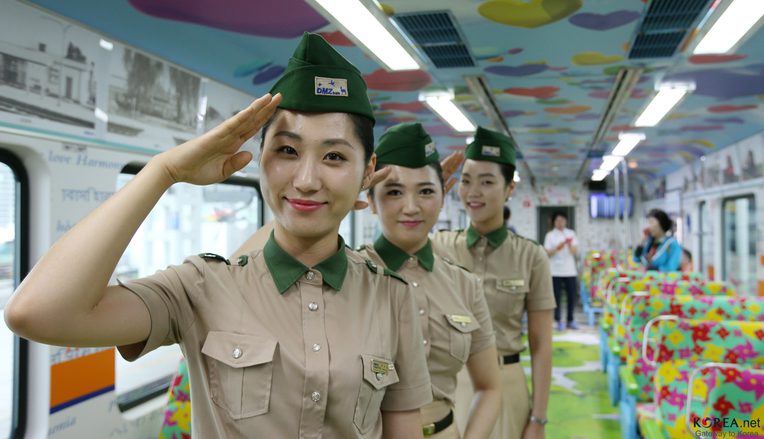
EJK: The train station at Baengmagoji, like the one at Dorasan Station on the western side of the DMZ, promises a future of reunification entailing the reconnection of predivision infrastructures, which were built by the Japanese colonial administration to secure and transport natural and human resources across its colonial territories in Manchuria and Korea. Today, the promise of a unified Korean peninsula provokes sentimental, nationalist longings, as reflected in the slogan that appears on the sign. The reconnection of rail links are framed as progress and preparation for future reunification at a moment when relations between the two Koreas have reached a historic low point. Yet beyond symbolic expressions of commitment to peaceful reunification, anticipatory agendas of the state and politicians are more pragmatically oriented around regional links that would connect terrestrial trade routes between South Korea and the European continent, in what South Korean President Park Geun-hye calls the “Silk Road Express.” These imaginaries and projects coexist and depend upon each other, with reunification and political détente increasingly tied to common economic goals rather than the overcoming of ideological antagonisms.
JC: Finally, you are careful not to settle for a consideration of landmines and their expected explosive function as “anti-infrastructural,” demonstrating instead the ontological instability from which “novel configurations among humans and nonhumans” might emerge. In light of this, how might your notion of roguishness be a useful conceptual tool to keep at the back of one’s mind when it comes to studying infrastructures at large?
EJK: Roguishness, in my framing, is less about technology gone amok (e.g., Terminator-style) and more about attending to the ecological embeddedness and spatiotemporal scales of infrastructures, as well as the unpredictable relations they stage among humans and nonhumans. In this article, I take an infrastructural approach to landmines, combined with insights from feminist science and technology studies, to consider the volatile materiality of mines and their multiple affordances as they reconfigure (post)war landscapes. An attention to roguishness might be useful in other studies of infrastructure by way of being alert to how agency is (re)distributed across networks of humans and nonhumans without falling prey to technological determinism or a vitalist approach, both of which risk muting more nuanced questions of power and ethical responsibility. In this effort, I follow James Ferguson (2012, 562), who suggests that “the intellectual and political task” is “to move from the de facto connectedness that is unmistakable at the level of [. . .] infrastructure toward forms of ethical and political recognition, responsibility and inclusion that would be able to operate at the same level.” My deployment of roguishness doesn’t presuppose the inherent moral value of any technical system or infrastructure, but takes into account multiple scales, temporalities, and relations that constitute the political.
References
Ferguson, James. 2012. “Structures of Responsibility.” Ethnography 13, no. 4: 558–62.
